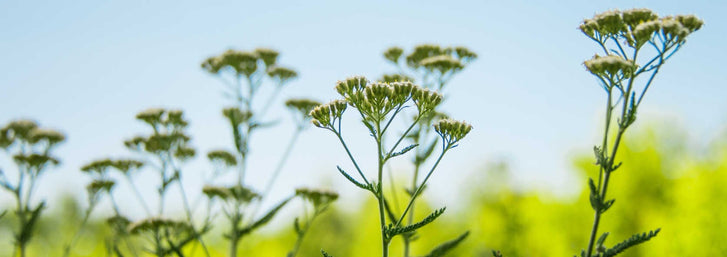
Jordan Freytag

For the last five years or so, we’ve been attempting to grow our own giant pumpkin with some troubling results. One year, our vine only grew about twenty feet long before giving up. Trial and error, we quickly learned is the name of the game. This year was our year. We’ve been wanting to grow our own contender for the Ginormous Pumpkin Regatta we throw every year here in Salt Lake City, and this, year we can say we’ve done it.
We used seeds from one of our friends at the Giant Pumpkin’s Growers Association. Some things we knew going into it because of our past failures, were (a) giant pumpkins need constant attention and care and (b) we’d have to be patient and able to adapt when issues arose, and (c) a lot of it comes down to having ideal weather and plain old luck. Very quickly, we discovered that growing giant pumpkins is a full-time job—and a gamble to maintain them through the entire season.
SOWING & GERMINATION
We decided to place two of our strongest starts and cut back the vine that underperformed, but surprisingly both vines exploded with growth. We started them in May and pretty soon, we were able to select the pollinated bulb that was to be our “contender.” As seen in the picture, the vine that produced our contender came from a pumpkin that weighed in at 796.5 pounds; this is a good way to estimate the final size and weight of your specimen. So, for us, we won’t accept weight below 600 pounds. Our second vine was a contingency vine and since it was still going strong, we decided to let grow instead of cutting it back.
 (Figure 1) Sowing and Initial Growth
(Figure 1) Sowing and Initial Growth
GROWTH OVER TIME
We decided to let bees naturally pollinate our pumpkin, allowing mother nature to remain in the driver’s seat, and it worked quite well for us—at times we even missed a few some mornings, finding pollinated bulbs in the evenings and vice-versa. It is amazing to see mother nature’s complex system at work, witnessing how quickly the two vines sprawled, producing male and female blossoms at a nearly inconceivable rate.
 (Figure 2) Post Pollination and Continued Growth
(Figure 2) Post Pollination and Continued Growth
What started out as a pregnant bulb has matured into a giant, putting on up to 20 pounds per day. Soon, Lance’s backyard was transformed into a thick pumpkin patch, overflowing with vines, and large flat leaves acting as solar panels, turning the sun’s energy into nutrients.
+ MAINTENANCE
It took some hard work and dedication to say the least: picking blossoms by the dozen every morning and evening once we’d established which pollinated fruit would become our pumpkin, constructing a shade apparatus that had to be adjusted and readjusted due to the sometimes-schizophrenic weather of Utah, fertilizing repeatedly, and maintenance task after maintenance task.
 (Figure 3) Pile of Picked blossoms, male and female
(Figure 3) Pile of Picked blossoms, male and female
TROUBLESHOOTING
Running into problems is just par for the course when growing giant pumpkin and we’ve had our share, including realizing that the pumpkin had grown too big to pile more sand beneath it to (a) create a substantial bed for the gourd and (b) to help us move out of the patch later on. If you were to sit and watch it all day, I swear you’d be able to watch the pumpkin growing. But recently, we ran into a problem that many pumpkin growers have nightmares about: our main stem split.
 (Figure 4) Our split stem and solution
(Figure 4) Our split stem and solution
We neglected to pull the tap roots off the main vine near the pumpkin. With continued growth, the roots pulled the vine in as the pumpkin grew taller. After talking with our fellow growers, we decided to use padded tomato wire to pull the stem back together and covered with a plastic lid to keep moisture off the wound. To help the vine heal, the idea is to keep the affected area dry. If water or moisture were to make its way into the cracked stem, chances of rot would sky-rocket toward inevitable. But our luck reserve must have been full because it continued to grow splendidly.
Once we entered September, we started having concerns that frost might sneak into the pumpkin patch in the night and finishing the job the cracked stem started. But even with the onset of chilly nights and frosty mornings, our gourd survived under a frost blanket. Recently, as we near October, half of our vines perished due to frost, our conniving comrade.
INCHING TOWARD HARVEST
Using the OTT method of estimating weight, we began to notice that our pumpkin, in its early stages, was putting on about twenty pounds a day. But quickly, that estimate quadrupled to where, on an ideal day, our giant was putting on eighty pounds in one day! According to our calculations then, we figured it was weighing in close to 600 lbs!
You may be wondering what happened to our second vine that we allowed to continue growing instead of terminating. Well, it produced a pumpkin that was nearly comparable to our main contender. We started referring to this vine as our insurance vine (especially when our main stem split!). The second pumpkin, we are estimating, is about 100 to 150 pounds lighter than our main gourd.
 (Figure 5) Main Giant (left) & the Back-up Giant (right)
(Figure 5) Main Giant (left) & the Back-up Giant (right)
The early days of October got cold enough at night to bring in a frost that killed our vines. Meaning, it’s time to harvest this beast! We figured that with enough hands and arms, we could get this giant gourd out of the patch and into Robb's truck safe and sound. We did, using a heavy-duty tarp and blankets. As you can see, we couldn’t be prouder of the final product.
 (Figure 6) Getting that sucker into Robb's truck!
(Figure 6) Getting that sucker into Robb's truck!
Of course, we paraded the gourd around the warehouse so everybody could marvel at this amazing product of mother nature! Who says pumpkins aren’t magical? The way people’s faces light up around a giant one (even though ours is considered on the small scale of the spectrum) tells us they are. Although we were disappointed slightly by its final weight, coming in at 522 pounds, we were proud to see the fruit of our labors, literally. And after a few years of failing, this giant gourd gives us hope and anticipation for the years to come of growing these beasts.
 (Figure 7) A Pumpkin Parade through the warehouse
(Figure 7) A Pumpkin Parade through the warehouse
Until the next growing season, we have the epic Ginormous Pumpkin Regatta to look forward to on October 21st! And our giant is eagerly waiting out the days until it can hit some waves!
Leave a comment
Your email address will not be published. Required fields are marked *
2 comments
Julia
What a great blog! I have wondered about this for years. Thank you so much for writing about it.
Maria A. Blaisdell
I ENjoyed your PUMPKIN GROWING. They are so BEAUTIFUL. thank you
Further Reading

10 Natives of the Southwest USA for Pest Control
Written By Lara Wadsworth The Southwestern United States is a region incredibly unique to the rest of the country. The hot, dry weather can be challenging for plants and animals to thrive without additional help. That is why gardening with natives can ...

Ashleigh Smith
2024-04-157 min read0
Spring Into Action - Celebrating Earth Day
Written By Chelsea Hafer Spring is quickly arriving, and that means that Earth Day is near! Earth Day is the perfect occasion to appreciate our wonderful planet and all that it does for us and think of ways you can give back to it. In this blog post, w...

Ashleigh Smith
2024-04-154 min read0
Everything You Need To Know About Rain Gardens
Written By Lara Wadsworth Rain gardens are quickly gaining popularity for their perfect marriage of utility and beauty. What simply looks like a beautifully landscaped garden is actually a native habitat that serves as a storm drain and water sponge. B...

Ashleigh Smith
2024-04-085 min read1
Northeastern Natives for Attracting Beneficial Insects
Written By Lara Wadsworth The Northeastern United States is rich with American history, but did you also know that it is rich in plant biodiversity? Nature has learned through time how to work in harmony with the various species that attempt to thrive....

Ashleigh Smith
2024-04-086 min read1



